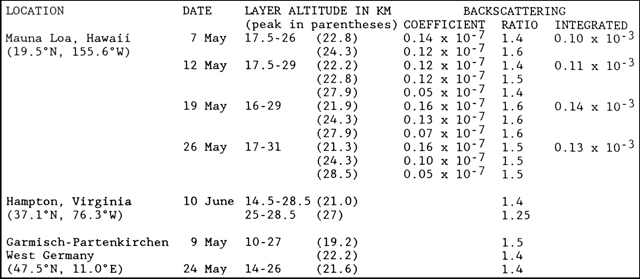Report on Atmospheric Effects (1980-1989) — May 1987

Atmospheric Effects (1980-1989)
Scientific Event Alert Network Bulletin, vol. 12, no. 5 (May 1987)
Managing Editor: Lindsay McClelland.
Atmospheric Effects (1980-1989) Ruiz aerosols persist in stratosphere
Please cite this report as:
Global Volcanism Program, 1987. Report on Atmospheric Effects (1980-1989) (McClelland, L., ed.). Scientific Event Alert Network Bulletin, 12:5. Smithsonian Institution.
Atmospheric Effects (1980-1989)
All times are local (unless otherwise noted)
Lidar in Hawaii, Virginia, and Germany continued to detect remnants of the aerosols from the November 1985 eruption of Ruiz (figure 41). Total backscatter over Hawaii increased in late May, as a higher altitude layer, centered around 28 km, became evident. This material lacked the sharp sublayering that generally characterizes fresh aerosols, and no large explosive eruptions have recently been reported.
Smoke from major forest fires in China that started 6 May could be tracked on polar orbiting satellite imagery as it moved over Kamchatka and S of the Aleutian Islands. The maximum altitude reached by the smoke was uncertain.
Information Contacts: Thomas DeFoor, Mauna Loa Observatory, P.O. Box 275, Hilo, HI 96720 USA; Horst Jäger, Fraunhofer-Institut für Atmosphärische Umweltforschung, Kreuzeckbahnstrasse 19, D-8100 Garmisch-Partenkirchen, West Germany; William Fuller, NASA Langley Research Center, Hampton, VA 23665 USA.

